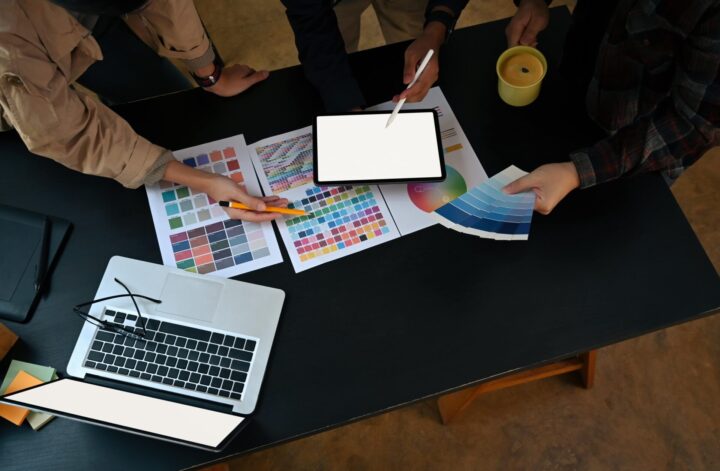In the fast-paced world of marketing, capturing the attention of consumers has never been more important. One of the key elements in winning this attention battle is the art of print design. Understanding the principles of visual design and applying them to print materials is crucial in creating effective marketing campaigns.
Color theory plays a vital role in print design, as different colors evoke different emotions and can greatly impact how a message is perceived. From brochures and flyers to business cards and banners, print design encompasses a wide range of materials, each requiring its own approach and style. Graphics also play a significant role, whether it’s through illustrations, logos, or photographs, they bring concepts to life and engage the viewer.
By carefully selecting colors, considering composition, and balancing visual elements such as negative space and visual weight, designers can create powerful and memorable pieces that effectively convey a brand’s message. Utilizing these design principles not only enhances the overall aesthetic appeal of print materials, but also ensures that the intended message is communicated clearly and effectively.
Understanding Color Theory for Print Design
Understanding color theory is essential in print design as it plays a crucial role in creating visually appealing and effective designs. Color theory encompasses the principles and science of color, including the study of how colors interact with each other and how they are perceived by the human eye.
In print design, color theory guides the selection and combination of colors to evoke specific emotions, convey messages, and create a harmonious visual experience. The principles of color, such as color harmony, contrast, and saturation, help designers achieve balance and a sense of unity in their designs.
Color theory is particularly relevant in creating effective designs for print mediums such as magazines and newspapers. The strategic use of color can draw attention to important elements, guide the reader’s eye, and enhance the overall visual hierarchy of the layout. Additionally, color can create associations and foster brand recognition, making it an invaluable tool in the development of a brand identity.
Whether designing for colorant-based printing or digital environments, understanding color theory allows designers to make informed decisions about color palettes, ensuring consistency and coherence across all printed materials. By applying the principles of color theory in print design, designers can create visually compelling and impactful designs that effectively communicate messages and engage the audience.
Exploring Different Types of Graphics Used in Print Design
Graphics are an integral part of print design, playing a crucial role in effective communication and visual storytelling. They help to engage the audience, convey information, and create a memorable visual experience. Here are some different types of graphics commonly used in print design:
- Logos: Logos are visual representations of a brand or company. They serve as a visual identifier and help to establish brand recognition and credibility.
- Typography: Typography refers to the visual design and arrangement of text. It includes the selection of fonts, sizes, and spacing to create a visually appealing and legible layout.
- Illustrations: Illustrations are hand-drawn or digitally created visuals that enhance the overall design. They can add creativity, personality, and a unique touch to printed materials.
- Infographics: Infographics are graphic representations of complex information or data. They effectively summarize information and make it easier to understand by incorporating visuals, charts, and graphs.
- Photographs: Photographs are powerful visual tools that can capture the attention of the audience and evoke emotions. They can add authenticity, context, and visual interest to printed materials.
By using a combination of these graphics in print design, designers can create visually compelling and impactful materials that effectively communicate messages and engage the audience.
Principles of Visual Design Applied to Print Design
In the world of print design, understanding and applying the principles of visual design is crucial for creating effective and impactful compositions. These principles, such as balance, contrast, dominance, hierarchy, and proportion, help guide designers in their quest to capture the attention of the audience and convey their message with clarity.
- Balance is a fundamental principle that ensures that the elements of a composition are evenly distributed, creating visual harmony. Whether it be symmetrical or asymmetrical, achieving balance in print design helps maintain the reader’s interest and prevents the piece from feeling cluttered or overwhelming.
- Contrast is another essential principle that involves the use of opposing elements, such as light and dark, to create visual interest. Contrast not only draws attention to specific areas but also helps establish a clear hierarchy and guides the reader’s eye through the composition.
- Dominance relates to the focal point or the main element of a design. It is the element that captures the viewer’s attention first and creates impact. By strategically placing dominant elements, designers can direct the flow of visual information and emphasize key messages.
- Hierarchy is the arrangement of elements in a composition, based on their importance or significance. Designers use various techniques such as size, color, and positioning to establish a clear hierarchy that enables readers to navigate and understand the content easily.
- Proportion is a key aspect of composition, as designers need to consider the size, scale, and proportion of different elements in order to create a visually appealing and balanced design that resonates with the target audience.
- When applying these principles to print mediums like magazines or newspapers, designers must consider the limitations and characteristics of the medium. They should utilize white space effectively, ensuring that the design is not overcrowded and allowing the content to breathe. Additionally, designers should pay attention to the layout and composition, creating a cohesive and visually pleasing design that complements the content.

Conclusion
In conclusion, print design is a powerful medium that can be used to effectively communicate messages to the target audience. By understanding and applying the principles of visual design, designers can create effective and impactful compositions for print materials. Through balance, contrast, dominance, hierarchy, and proportion, designers can create engaging designs that capture the attention of their intended audience and accurately convey their message.


